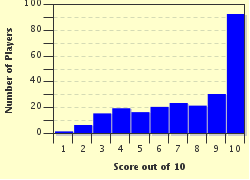Quiz Answer Key and Fun Facts
1. In what regions of Australia can you find a funnel-web spider?
2. Where do funnel-web spiders make their homes?
3. What does a funnel-web spider look like?
4. What sort of diet do funnel-web spiders enjoy?
5. Is it the male or female funnel-web spider that can be lethal to humans?
6. How far can a funnel-web spider jump?
7. OH NO! You want to go for a swim in the pool but there is a funnel-web at the bottom of the pool. Is it dead?
8. What sort of animals can the venom of a funnel-web spider kill?
9. What is the scientific name for the Sydney funnel-web spider?
10. After all this talk of the lethal funnel-web venom you'd think there would be an antivenin to treat it. Is an antivenin available?
Source: Author
Tizzabelle
This quiz was reviewed by FunTrivia editor
crisw before going online.
Any errors found in FunTrivia content are routinely corrected through our feedback system.

